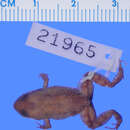Description
(
Anglèis
)
fornì da AmphibiaWeb articles
Eleutherodactylus intermedius is a tiny frog, with males reaching 17 mm and the larger females measuring up to 20 mm in SVL. The digits are small and the digital discs are absent. There is no webbing between the toes. The vomerine teeth, behind the choanae, are in a rather long series (Barbour and Shreve 1937; Schwartz and Henderson 1985; Schwartz and Henderson 1991). These frogs are variable in color, from light gray, mottled with brown and darker gray, to very dark brown, variously marbled or mottled. In some individuals there are narrow, whitish dorsolateral streaks or a narrow, whitish mid-dorsal line. Other markings that may be present include a dark interocular bar, a canthal band, and a black band running from the eye along the supratympanic fold, all of them at times poorly defined or absent. Some individuals have a black spot near the groin. The venter is dark brown, densely covered with white or yellowish white spots. (Barbour and Shreve 1937; Schwartz and Henderson 1985; Schwartz and Henderson 1991).Eleutherodactylus intermedius is a member of the subgenus Euhyas. (Heinicke et al. 2007).
- Estrada, A. R. (1992). ''Comentarios sobre Eleutherodactylus intermedius Barbour et Shreve, 1937 de la Región Oriental de Cuba.'' Comunicaciónes Breves de Zoología Academia de Ciencias de Cuba, Havana, 1992, 12-14.
- Estrada, A.R. and Hedges, S.B. (1996). ''A new frog of the genus Eleutherodactylus from eastern Cuba (Anura: Leptodactylidae).'' Herpetologica, 52(3), 435-439.
- Hedges, S. B. and Díaz, L. M. (2004). Eleutherodactylus intermedius. In: IUCN 2007. 2007 IUCN Red List of Threatened Species. http://www.iucnredlist.org/. Downloaded on 11 November 2007.
Distribution and Habitat
(
Anglèis
)
fornì da AmphibiaWeb articles
This species is endemic to Cuba and it is found only in the Sierra Maestra and Sagua-Baracoa mountains, in eastern Cuba. This is a terrestrial species found in the leaf litter of rainforests at elevations between 500-1974 m (Schwartz and Henderson 1991)
Life History, Abundance, Activity, and Special Behaviors
(
Anglèis
)
fornì da AmphibiaWeb articles
These frogs are active by night, by day taking refuge under rocks, logs and other objects. Males seem to attend the clutch (parental care). Males vocalize from ground or very low vegetation. Calls consist of a series of evenly spaced “chirps”, although this frog typically gives a single note per call and only occasionally breaks into multiple-note calls. The dominant frequency is 2.9-3.0 kHz (Schwartz and Henderson 1991; Estrada 1992; Estrada and Hedges 1996).
Life History, Abundance, Activity, and Special Behaviors
(
Anglèis
)
fornì da AmphibiaWeb articles
This species is threatened by habitat destruction and deforestation, due to agriculture, woodcutting, disturbance from tourists, and infrastructure development for human settlement (Hedges and Diaz 2004).
Eleutherodactylus intermedius: Brief Summary
(
Anglèis
)
fornì da wikipedia EN
Eleutherodactylus intermedius is a species of frog in the family Eleutherodactylidae endemic to eastern Cuba where it is known from the Sierra Maestra and Sierra del Cobre. Its common name is Pico Turquino robber frog, in reference to its type locality.
- licensa
- cc-by-sa-3.0
- drit d'autor
- Wikipedia authors and editors

